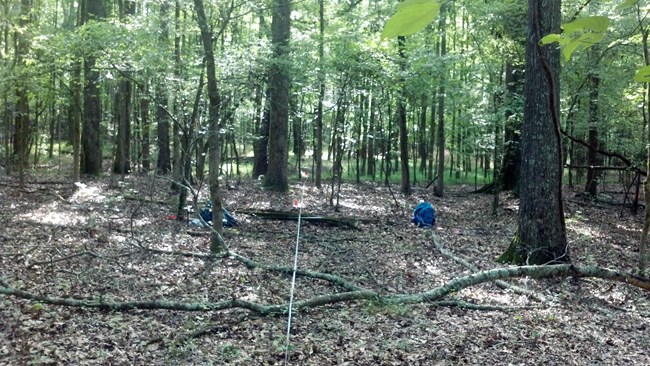
NPS Photo
This Revolutionary War site preserves the frontier village of Ninety Six and the earthworks associated with its role as a British outpost. It was the scene of repeated confrontations between loyalists and patriots, and one of the longest sieges of the war conducted by the Continental Army. Ninety Six National Historic Site is approximately 1,000 acres, comprised primarily of mixed woods, riparian areas, and some grassy areas, particularly around the earthworks. Star Fort Lake is a 25 acre impoundment within the Site. Other water resources include Little Pond and several springs in the Spring Branch area.
The Cumberland Piedmont Network I&M program has provided this park with a vegetation community classification and map, a wetlands inventory, and updated vascular plant and vertebrate species lists. During the vegetation community classification work, 18 distinct associations were documented and mapped, including an oak bottomland forest containing large stands of undisturbed oak, towering above a showy spring ephemeral called the "rain lily" (Zephyranthes atamasca).
The network monitoring program at this park includes four vital signs that involve repeated visits to established sites, following procedures established by each monitoring protocol. These four vital signs are: forest vegetation communities, invasive species early detection, ozone/foliar injury, and water quality. Water quality monitoring began in 2004 and continues on a quarterly schedule, every-other-year (even years) at four sites. Forest monitoring began in 2011–2012 with the establishment of 16 long-term monitoring plots. More new plots will be established in upcoming years, followed by a five-year revisit schedule, occurring in mid-July. Ozone levels and foliar injury are assessed on-site every six years, beginning in 2013. The Invasive Species Early Detection protocol was completed in 2012 and will be used by field crews to monitor for priority exotics during their scheduled field work.
Park managers are using inventory and monitoring data to create resource stewardship strategies for achieving desired future conditions. The links to inventory and monitoring reports are provided on this page.
For more Information contact:
Steve Thomas, Network Program Manager, CUPN offices at Mammoth Cave NP
Select a Park:
Select a Species Category (optional):
Visit NPSpecies for more comprehensive information and advanced search capability. Have a suggestion or comment on this list? Let us know.
Last updated: January 12, 2021
